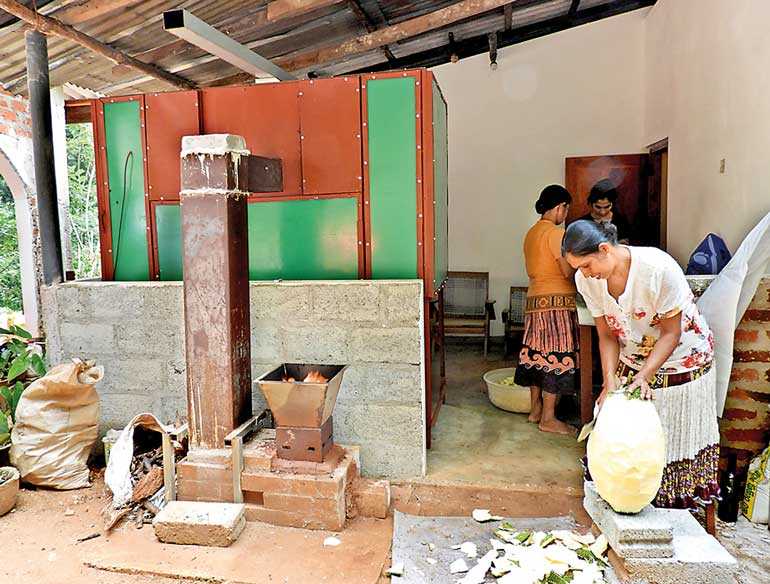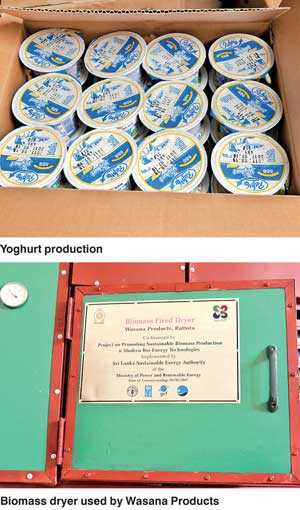Thursday Jan 30, 2025
Thursday Jan 30, 2025
Tuesday, 21 August 2018 00:00 - - {{hitsCtrl.values.hits}}

By Sampath Ranasinghe
In developing countries some 2.5 billion people are forced to rely on biomass—fuelwood, charcoal and animal dung—to meet their energy needs. These people are energy poor, in that they have an absence of choice in the energy they access or use in their daily lives. Therefore, biomass plays an enormously important role in the lives of the rural poor in these developing countries, in the form of wood for cooking and heating.
To mitigate this need, the United Nations General Assembly designated 2012 as the International Year of Sustainable Energy for All with three interlinked objectives: to ensure universal access to modern energy services; to double the global rate of improvement in energy efficiency; and to double the share of renewable energy in the global energy mix.
In January of 2016, given the importance of energy in climate change mitigation, reducing poverty, and meeting the United Nations sustainable development agenda, 17 Sustainable Development Goals (SDGs) were set out with clear targets for all countries to adopt in accordance with their own priorities and the environmental challenges of the world at large.
According to the Report of the Secretary-General, ‘Progress towards the Sustainable Development Goals,’ E/2017/66, “By 2017, the progress in every area of Goal #7 – ‘ensure access to affordable, reliable, sustainable and modern energy for all’ – fell short of its targets.
“Globally, 85.3% of the population had access to electricity in 2014, an increase of only 0.3 percentage points since 2012. That means that 1.06 billion people, predominantly rural dwellers still function without electricity. Half of those people live in sub-Saharan Africa.
“Access to clean fuels and technologies for cooking climbed to 57.4% in 2014, up slightly from 56.5% in 2012. More than three billion people, the majority of them in Asia and sub-Saharan Africa, are still cooking without clean fuels and more efficient technologies.
“The share of renewable energy in final energy consumption grew modestly from 2012 to 2014, from 17.9% to 18.3%. Most of the increase was from renewable electricity from water, solar and wind power. Solar and wind power still make up a relatively minor share of energy consumption, despite their rapid growth in recent years. The challenge is to increase the share of renewable energy in the heat and transport sectors, which together account for 80% of global energy consumption.
“From 2012 to 2014, three quarters of the world’s 20 largest energy-consuming countries has reduced their energy intensity – the ratio of energy used per unit of GDP. The reduction was driven mainly by greater efficiencies in the industry and transport sectors. However, that progress is still not sufficient to meet the target of doubling the global rate of improvement in energy efficiency.”
Source: Report of the Secretary-General, ‘Progress towards the Sustainable Development Goals,’ E/2017/66.

Energy and the gender gap
One of the key aspects of economic poverty is related to energy. Energy poverty, which disproportionately affects women who are primarily responsible for collecting fuel and water at a community level, can benefit greatly by the use of modern biomass energy sources. However, besides household energy consumption, women are also capable of improving the livelihoods of their families through various small-scale entrepreneurial projects that use renewable energy.
A Sri Lanka perspective
In Sri Lanka, rural women play a significant role in economic and social development, contributing to the wellbeing of their families. Many of these women manage their household expenses and family commitments through small scale entrepreneurial businesses which can depend on biomass energy due to affordability and the availability of fuelwood. As such, the empowerment of women in Sri Lanka is vital for their development.
To alleviate this problem, an island wide renewable energy project called Promoting Modern Sustainable Biomass Energy conducted by the Ministry of Power and Renewable Energy together with the Sri Lanka Sustainable Energy Authority and supported by the FAO and UNDP provides island wide energy services and programmes to promote women’s skills development and employment. 
Many of these women, having explored various options of cost effective methods to run their businesses have now adopted biomass energy and through the Modern Sustainable Biomass Energy Project have availed themselves of modern technologies to improve their small enterprises and save energy costs.
Case Study – How women up-scaled their fish drying business
Tangalle is an important hub for deep sea fishing and has a thriving local dry fish industry. However, unlike drying other consumables, the process of drying fish is long and time consuming, subject to environmental hazards, unhygienic conditions and prone to contamination. This industry is also pursued by women who use this extra income to sustain their households.
In 2016, through the assistance of the ‘Sustainable Biomass Energy’ project, dryers have been introduced to rural communities to help them improve and sustain their home-businesses and to yield higher benefits.
For nine women the 40 KW flatbed dryer has vastly improved their production, productivity and incomes. In 2016, they were assisted by the Sustainable Biomass Energy with initial project financing and have cut short their production hours from ten to four hours a day and increased their production from 200 kgs to 800 kgs per month.
After two years of using this modern biomass dryer, their fish drying business has reached a new level in its final product and has increased the living standards of these women working in the organisation. It is a fine depiction of women entrepreneurship which has to be encouraged.
During off season, the dryer is used to dry chillie, pepper and cinnamon, ensuring the women have a supplementary income throughout the year.
Case Study – Wasana Products gets lifeline for home-based entrepreneurship
Shanthi Menike is a single mother who worked in the Middle East to earn money to educate her daughter and to complete a half-built house. Although she managed to educate her daughter who qualified as an IT teacher, her house remained unfinished and her hard-earned money soon finished. In desperation, Shanthi started a home-based business of drying fruit and vegetables. Initially she used an electric dryer which was, according to her, far too expensive.
In January 2017, through the assistance of the FAO and UNDP’s Sustainable Biomass Energy Project Shanthi invested in a 20 KW biomass-fired dryer through a financial grant for Rs. 171,500. Her production has increased from four kgs to 10 kgs of fruit and vegetables daily. Firewood is sourced free of charge from the local timber store.
Although her supply and demand is relatively low at present, Shanthi has the option of increasing her manufacture in the future to overseas markets. In addition, she can also use the dryer for drying other consumables, thus giving her the option of increasing her income.
Case Study – Biomass technology enriches RichMe dairy products
Yogurt has always been a popular dairy-based meal/snack amongst all age groups. In Sri Lanka, yogurt is consumed as a snack and dessert amongst children and adults. Yogurt contains lower amounts of lactose than milk because the lactose in yogurt is converted to lactic acid by the bacterial cultures.
Manthika Dilrukshi and her husband Chathura Munasinghe started their yoghurt making business, RichMe Foods and Dairies, in 2007.
For years, their biggest business cost was for power generation and the price they doled out for almost three gas cylinders per day for the heating process. “That was our biggest cost and we hardly made a profit after paying off these bills,” said Dilrukshi. Also, there were times when the production had to be halted or discarded because of contaminants, or uneven heating processes that ruined the entire production.
In 2016, the duo approached the Sustainable Biomass Energy project and through a co-financing availed themselves of a 12KW biomass fired water heating system for Rs. 425,000. This heater can boil 230 litres of milk per month, saving them around Rs. 60,000 per month. Sustainable fuelwood is sourced from a neighbourhood timber store.
According to her, production has increased 100% – from 1,500 batches of yogurt to 3,000 per day. In addition, the temperature control allows them to perfectly manipulate the heat required to the exact second. The entire manufacturing process is clean, safe from fire hazards, hygienic and faster.
In conclusion, it is safe to say that access to modern energy is also a key enabler for women’s empowerment (SDG 5 – Gender Equality) – because access to energy makes a significant difference to their health and well-being.
While access to energy services would not necessarily guarantee gender equality, it would go a long way in relieving women and girls of the drudgery associated with their daily tasks and providing them time for income-generating opportunities and education.
(The writer is National Project Manager, FAO-UNDP Joint Project on Sustainable Biomass Energy.)